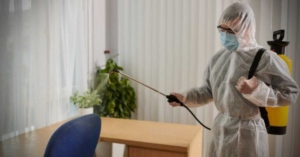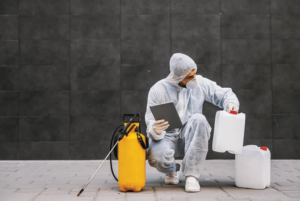Pests can damage our property and invade our privacy. They can also cause health issues, like fleas and ticks that spread diseases, and they can be just plain annoying, like ants or termites.
Rodents like rats and mice gnaw on electrical wires, causing a fire hazard. They can also carry diseases such as hantavirus pulmonary syndrome, leptospirosis and salmonella. Contact Pest Control Mesquite TX now!

A pest is any creature that interferes with human concerns, whether it damages crops or livestock, ruins home and work environments or spreads disease. Creatures that are considered pests may also include wildlife such as birds, mammals, reptiles and amphibians and invertebrates such as insects, mites, flies and wasps. In general, humans are intolerant of any creatures that cause damage or nuisance and disrupt human activities. For example, an elephant is unobjectionable in its natural environment, but it becomes a pest when tramples crops.
Some pests can be controlled through prevention. This includes assessing the environment and identifying areas where pests are likely to be found. It also involves noting any unusual weather conditions that could affect pest activity. For example, extreme temperatures can slow or halt pest reproduction and development. Weather can also affect the availability of food and water to pests.
Other pests can be controlled through suppression and eradication. This requires a close monitoring of pest populations to determine when control actions are necessary. It is also important to assess the impact of the pest on other organisms and the environment. Eradication can be difficult and is usually reserved for situations where a foreign pest has been accidentally introduced and has become established.
The type of pest that needs to be controlled will influence the kind of treatment that is used. For example, a physical or biological method of pest control is preferable to using chemical poisons, which are harmful to the environment and can even be toxic to people.
Insect pests are often the focus of pest control. This is because they are easy to detect and can be destructive. However, there are many other types of pests, such as fungi, viruses and nematodes, that can cause serious problems to plants and crops.
There are many factors that can affect pest populations, including climate, natural enemies, food and water supplies and the availability of shelter and overwintering sites. In addition, some landscape features such as mountains and bodies of water restrict the movement of pests. This is an important factor in pest control because it limits the number of organisms that must be killed to reduce the pest population.
Exclusion Methods
The best pest control strategy is to prevent the entry of pests rather than relying on toxic chemicals to eradicate infestations. Exclusion methods include a wide range of techniques that seal gaps and routes pests use to access buildings and structures. For example, screening windows and doors, sealing cracks and crevices, installing door sweeps and using copper mesh in ductwork are ways to exclude pests from homes and businesses. These strategies also reduce a home or building’s attractiveness to pests by eliminating crumbs and food sources that attract them.
Often, pests find their way indoors because of tiny holes or gaps that aren’t noticed. For example, rodents need only a 1/4″ gap to enter a house, and cockroaches can squeeze through spaces as small as 1/8″. Fortunately, there are many products available that can be used to seal these gaps and prevent pests from entering structures.
One of the most common pests to gain access to indoors are ants, which can be enticed by food sources in buildings and structures. The best way to discourage ants from entering is by reducing the food and water that is available on or near a structure. This is accomplished by regularly cleaning up messes, storing food in sealed containers and removing trash regularly.
Besides reducing the amount of food and water available, the use of pesticides can be reduced by excluding pests from indoor spaces. This is achieved by performing a thorough inspection to identify and map entry points for pests into a structure and then sealing these areas.
A successful exclusion strategy can dramatically reduce the need for chemical treatment. This is especially important for a large commercial property with numerous entry points into which pests can invade.
In order for exclusion to be successful, it must be part of an integrated pest management (IPM) program. The best IPM plans incorporate exclusion strategies, such as reducing the attraction of the building to pests by removing or trimming foliage, reducing food and water sources on or around the structure and controlling weeds that provide shelter to pests.
Pesticides
Pesticides are chemicals that destroy or prevent the growth of undesirable plants, insects, rodents and fungus. They may be made synthetically, or they may come from living things (biopesticides). They are available in many forms, including sprays, liquids, powders, granules and baits. They are used to control unwanted organisms on crops, in forests and in residential, commercial and public areas. They can also be inhaled, ingested or absorbed through the skin. Most provinces and territories require that applicators, vendors and growers of pesticides be licensed, trained and certified.
Each pesticide has a unique mode of action, and it is designed to disrupt the biological process of the target organism. Mode of action is important because it helps to limit resistance development.
The active ingredient in each pesticide is the chemical that is harmful to the organism it targets. The active ingredient is usually combined with other ingredients to form the pesticide product that is sold and applied. The other ingredients are usually fillers, stabilizing agents, solvents and additives. The label for each pesticide lists the ingredients and a safety statement. It also includes directions for application, storage and disposal.
Before a pesticide is allowed for use on food, the Environmental Protection Agency (EPA) tests it and sets limits for residues in foods that can be consumed safely. These limits are called tolerances. If a food contains a high level of pesticide residue, it must be seized and destroyed by the government.
The residue levels of most pesticides on fruits, vegetables and grains are far lower than those that pose a health risk. However, some people still get exposed to low levels of pesticides in their homes, schools and work places. Some people are even exposed to the residues in their drinking water.
Some people are especially sensitive to pesticides, and the exposure is more likely when the substances are inhaled, ingested or touched on the skin. These individuals can develop symptoms such as rashes, dizziness and headaches. Others are more affected by long-term exposure, which can cause neurotoxic effects and cancer. Most of the data on the toxicity of pesticides comes from industry-funded studies, and these findings can be skewed by biases.
Safety
When pest control methods are used incorrectly, they can pose health risks for residents and workers. Some pesticides can contaminate food and damage homes, while others can cause asthma, allergies and other health problems. Safe pest control requires that building owners, managers and maintenance workers follow proper safety precautions when applying these chemicals.
The hazards that workers in pest control manufacturing face can be mitigated by conducting risk assessments, providing training and personal protective equipment, maintaining good housekeeping, and encouraging workers to report any safety concerns to their supervisors. Taking these steps will help to reduce the potential for workplace accidents and injuries, which can have negative impacts on worker morale, productivity, and employee retention rates.
Physical hazards in the pest control industry include slipping and falling, injuries from handling equipment and machinery, and exposure to hazardous chemicals. These risks can be minimized by conducting regular risk assessment, providing adequate training and education, providing workers with appropriate PPE, and ensuring that work areas are adequately ventilated.
Pest control manufacturers also face hazards from exposure to infectious diseases, such as vector-borne diseases like Lyme disease and West Nile virus. These can be minimized by implementing and monitoring appropriate preventive measures, including training employees on infection prevention practices, educating them on the signs and symptoms of common vector-borne diseases, and encouraging workers to practice good hygiene habits.
When working with pesticides, it is important to read and follow the label instructions carefully. This will ensure that the pesticide is properly dilute and mixed, and that it is used in a manner that will not pose a risk to people or animals. It is also important to wear the correct personal protective equipment, and to make sure that work surfaces are thoroughly cleaned at the end of each procedure.
Finally, it is important to keep pesticides in a secure location that is inaccessible to unauthorized personnel and to store them away from chemicals and materials that are sensitive to temperature extremes. This will help to prevent accidental contamination and theft of the pesticides. Proper storage will also help to prolong their effectiveness.




